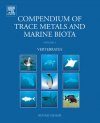![Compendium of Trace Metals and Marine Biota, Volume 2: Vertebrates Compendium of Trace Metals and Marine Biota, Volume 2: Vertebrates]()
Click to have a closer look
About this book
Contents
Customer reviews
Related titles
About this book
Each book has two main goals
1. Determine baseline concentrations of metals and metalloids in tissues of representative field populations of estuarine coastal, and open ocean organisms (Book 1:algae and macrophytes, protists, sponges, coelenterates, molluscs, crustaceans, insects, chaetognaths, annelids, echinoderms, and tunicates) (Book 2: elasmobranchs, fishes, reptiles, birds, mammals) and their significance to organism health and to the health of their consumers.
2. Synthesize existing information on biological, chemical, and physical factors known to modify uptake, retention, and translocation of each element under field and laboratory conditions. Recognition of the importance of these modifiers and their accompanying interactions is essential to the understanding of metals kinetics in marine systems and to the interpretation of baseline residue data.
Contents
1 INTRODUCTION
1.1 Literature Cited
2 ELASMOBRANCHS
2.1 Americium
2.2 Arsenic
2.3 Cadmium
2.4 Cerium
2.5 Cesium
2.6 Chromium
2.7 Cobalt
2.8 Copper
2.9 Iron
2.10 Lead
2.11 Manganese
2.12 Mercury
2.13 Nickel
2.14 Plutonium
2.15 Ruthenium
2.16 Selenium
2.17 Silver
2.18 Strontium
2.19 Tin
2.20 Zinc
2.21 Literature Cited
3 FISHES
3.1 Aluminum
3.2 Americium
3.3 Antimony
3.4 Arsenic
3.5 Barium
3.6 Beryllium
3.7 Bismuth
3.8 Boron
3.9 Cadmium
3.10 Cerium
3.11 Cesium
3.12 Chromium
3.13 Cobalt
3.14 Copper
3.15 Gallium
3.16 Germanium
3.17 Gold
3.18 Indium
3.19 Iron
3.20 Lead
3.21 Lithium
3.22 Manganese
3.23 Mercury
3.24 Molybdenum
3.25 Neptunium
3.26 Nickel
3.27 Niobium
3.28 Palladium
3.29 Plutonium
3.30 Polonium
3.31 Radium
3.32 Rhenium
3.33 Rubidium
3.34 Ruthenium
3.35 Scandium
3.36 Selenium
3.37 Silver
3.38 Strontium
3.39 Tellurium
3.40 Thallium
3.41 Tin
3.42 Titanium
3.43 Tungsten
3.44 Uranium
3.45 Vanadium
3.46 Yttrium
3.47 Zinc
3.48 Zirconium
3.49 Literature Cited
4 REPTILES
4.1 Aluminum
4.2 Antimony
4.3 Arsenic
4.4 Barium
4.5 Beryllium
4.6 Cesium
4.7 Cadmium
4.8 Chromium
4.9 Cobalt
4.10 Copper
4.11 Iron
4.12 Lead
4.13 Manganese
4.14 Mercury
4.15 Molybdenum
4.16 Nickel
4.17 Rubidium
4.18 Selenium
4.19 Silver
4.20 Strontium
4.21 Thallium
4.22 Titanium
4.23 Uranium
4.24 Vanadium
4.25 Zinc
4.26 Literature Cited
5 BIRDS
5.1 Aluminum
5.2 Americium
5.3 Antimony
5.4 Arsenic
5.5 Barium
5.6 Beryllium
5.7 Bismuth
5.8 Boron
5.9 Cadmium
5.10 Cesium
5.11 Chromium
5.12 Cobalt
5.13 Copper
5.14 Europium
5.15 Gallium
5.16 Indium
5.17 Iron
5.18 Lanthanum
5.19 Lead
5.20 Lithium
5.21 Manganese
5.22 Mercury
5.23 Molybdenum
5.24 Nickel
5.25 Plutonium
5.26 Rubidium
5.27 Selenium
5.28 Silver
5.29 Strontium
5.30 Technetium
5.31 Thallium
5.32 Thorium
5.33 Tin
`5.34 Tungsten
5.35 Uranium
5.36 Vanadium
5.37 Zinc
5.38 Literature Cited
6 MAMMALS
6.1 Aluminum
6.2 Americium
6.3 Antimony
6.4 Arsenic
6.5 Barium
6.6 Beryllium
6.7 Bismuth
6.8 Boron
6.9 Cadmium
6.10 Cesium
6.11 Chromium
6.12 Cobalt
6.13 Copper
6.14 Gold
6.15 Indium
6.16 Iron
6.17 Lead
6.18 Lithium
6.19 Manganese
6.20 Mercury
6.21 Molybdenum
6.22 Nickel
6.23 Palladium
6.24 Platinum
6.25 Plutonium
6.26 Polonium
6.27 Rubidium
6.28 Selenium
6.29 Silver
6.30 Strontium
6.31 Thallium
6.32 Tin
6.33 Titanium
6.34 Uranium
6.35 Vanadium
6.36 Zinc
6.37 Literature Cited
7 CONCLUDING REMARKS
7.1 General
7.2 Breadth of Coverage
7.3 Depth of Coverage
7.4 Literature Cited
INDEX
Customer Reviews



































